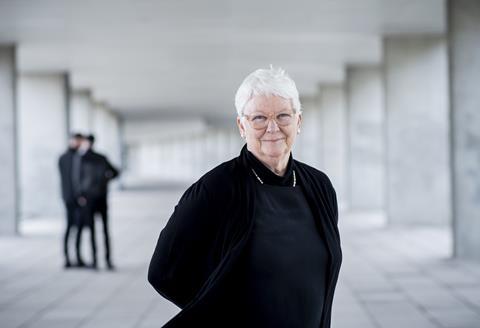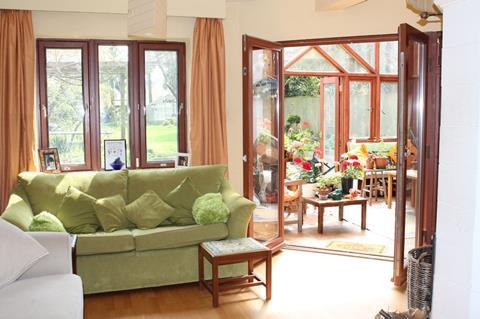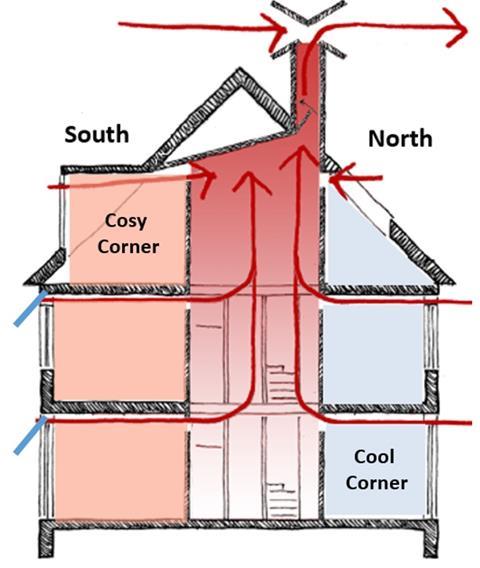We should focus less on heating and cooling entire buildings, and more on the comfort of the people who occupy them, writes Susan Roaf

If we are to meet the Paris Accords’ greenhouse gas (GHG) target of 1.5°C, then the UK’s emissions must fall by half by 2030 (seven years away!). This will require radical new thinking. The 20th century mantra of ’energy efficiency’ is of little use if only people who can afford to install and run efficient machines will be comfortable during extreme weather. Where is the climate justice in that? Thermally distressed people often become angry fast.
In the 2003 European heatwave, over 72,000 heat deaths were recorded, and of the 15,000 who died in France, many were poor and/or old living on top floors, under uninsulated roofs. In England in 2022, 2,800 over-65s died during the summer heatwaves when temperatures soared to above 40°C. We are now recommended to design for the UK summer peak temperatures of 45°C that may be common by 2050.
A new mantra for radical reductions in energy use and bills, ghg emissions, power-outage proof buildings and weather related ill-health and deaths may be Energy Sufficient Buildings. These can run for as much of the year as possible using only local natural energy (wind and sun) and also keep occupants thermally safe during extremes.
If some of us are really not that interested in global emissions, most of us are deeply concerned about paying our energy bills and staying comfortable while doing so. We also care about the health of our grandparents and children. The poor, the old, ill and young people always die first during extreme weather events.
Governments regularly produce eye-watering figures for the cost of renovating entire buildings stocks, based on figures like £95k for a three-bedroom house. Magic money tree thinking? Such mass refurbishment won’t happen in the next seven years.
Climate Refuges
After many poor older people died in the 2014 heatwave in Adelaide and the 2016 winter storms in Wellington, New Zealand, an affordable solution for existing and new homes seemed sensible. It was increasingly clear that all homes should contain a cold and hot weather refuge where possible. Under the title of Buy your Gran a Cosy / Cool Corner for Christmas, ideas for thermally safe spaces were explored that were simple to construct and could provide low energy, low cost comfort in more extreme weather. This requires us to:
a) See buildings as complex thermal landscapes
b) Heat or cool people – not buildings
Many of us already exploit the big difference in indoor micro-climates, escaping to snug bedrooms in winter, or sleeping downstairs in summer. As more of us work from home, low or no cost comfort becomes more important. Over much of the year this is not a problem but during the summer and winter months cool or cosy spaces may radically slash energy bills and GHG emissions too.

The Cool Corner
Based on a few simple Northern Hemisphere principles (fancy simulation models unnecessary):
- Summer heat is from solar gain manly from the South
- The most dangerous heat gain is from the hot West
- Hot air rises – cold air sinks
- Cold air and winds usually come from the North(ish)
- The landscapes and planting around a building matter
Choose the coolest corner of the house, one that can be shut off from the rest of it, possibly on the north/east wall on the ground floor? Extra insulation to the walls, floors and ceiling helps keep radiant heat from occupants. Traditionally timber wainscots worked well for seated people in both the heat and cold.
A thick wet plaster finish internally can provide extra thermal mass and cut down hot or cold air leakage into the room. A hydrothermally permeable water-based paint also helps stabilise humidity in the space. Include space for a bed / couch to rest on.
Perhaps its most important feature must be the opening window(s). A cool micro-climate outside with planting can lower temperatures indoors.
Minimise solar gain onto its walls, windows and from adjacent reflective pavements with shades, shutters, awnings, balconies, verandahs or structural overhangs. Note that internal blinds and curtains can help but once the sunlight is through the glass the heat is inside the space and cannot escape back out through the glass.

Make sure windows can be fully opened like a sash or side hung window. Top hung windows provide poorer comfort ventilation. If dangerous, simply fit an effective security grill onto the window. Problem solved. Replace unwieldy and insecure patio doors with a mix of easily usable flexible openings that can safely be left open overnight, or when the home is unoccupied to allow for night cooling of the space during hot periods.
Ideally buffer the space from other hot external walls with rooms or furniture. Make sure heat can be dumped easily up and out or sideways using pressure or buoyancy driven airflows (Figure 3). Creating flexible climate controls for the room means it can be adapted for comfort in other seasons too.
Ideally the room will have a ceiling, table or floor fan to enhance comfort at temperatures between c.25°C to 35°C (around upper mean skin temperature). Evaporative cooling is effective at temperatures above c.30°C, possibly with a fan moving air across a basin of water, or over damp blinds or even wet sheets hung over a window during heatwaves. Use a local air-conditioner during extremes, if the grid is not down.
The Cosy Corner
Reverse the thinking. Choose a south facing room with maximum solar gain, possibly higher up in the building, heated also by rising warm air indoors. Separate the cosy corner from adjacent spaces with walls, doors, temporary partitions or curtains to minimise draughts. Insulate the surfaces of the space if possible. Time to rethink flock wallpaper? Stop floor draughts with warm carpets. Mastic or plaster up draught sources around windows, skirting boards and doors. Draught strip doors.
Size windows to be large enough to heat the space but avoid excessive heat loss. Thick internal curtains can work well. Double/triple glaze the window(s) that can be opened slightly for fresh/cooling air when needed.
Buy a good warm chair to minimise heat loss from the sitter. Provide knee blankets and local low energy technologies like an electric heater, blanket, carpet or foot warmer. Possibly include a kettle for hot drinks or filling a hot water bottle. Cosy corners can save lives, not least those of the most vulnerable.

Open Plan or Broken Plan?
Perhaps the worst spaces to be in during extreme weather are commonly found in the grand design of many modern homes. Large open-plan living zones containing the kitchen, dining room and sitting area heated by efficient heat pumps that often cost more than predicted to run.
Add in a cathedral or barn roof into which any heat rises to sit under the ceiling in winter and perhaps a full wall of west or north facing patio doors towards ‘the view’, and the result may well be severe overheating or cold stress, and/or crippling energy bills for cooling and heating. That is fine if you are young and healthy and can afford it, but not good news for the planet.
So create a cool/cosy corner to protect your own loved ones who may be amongst the first to suffer during extreme weather events and associated grid failures. Those events are coming.
With the scale of the climate challenges we face now, a radical re-think of design priorities is inevitable. Key to the success of COP27 must be discussions around the mandating of Energy Sufficient Buildings and the aim of Comfort Justice for all.
Postscript
Susan Roaf is Emeritus Professor of Architectural Engineering at Heriot Watt University, Edinburgh. She is best known for her work on adapting buildings and cities for climate change. She has written and edited 22 books on sustainable design and climate change adaptation, including Adapting Buildings and Cities for Climate Change, by S. Roaf, D. Crichton and F. Nicol, Routledge, 2009.
















2 Readers' comments